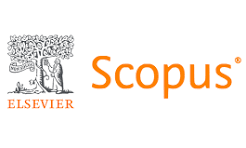COMPARISON OF TWO CRANIAL BASE LENGTHS AND FOUR ANGLES AMONG THREE SAGITTAL SKELETAL BASES IN ADULT POPULATION OF DISTRICT PESHAWAR, PAKISTAN
Abstract
Background: Research has shown that cranial base length, flexure and inclination play a role in the skeletal malocclusion in sagittal and vertical dimensions. The objectives of this study were to compare the two cranial base lengths and four angles among three sagittal skeletal bases in adult population of district Peshawar, Pakistan.
Material & Methods: This cross-sectional study was conducted in the Department of Orthodontics, Khyber College of Dentistry, Peshawar, Pakistan from February 2020 to March, 2020. Ninety lateral cephalograms were selected for the year 2019 from the database of department, with 30 from each group; Skeletal Class I, II and III. SN length (mm), SBa length (mm), N-S-Ba, N-S-Ar, SN-FH and SBa-FH were our ratio variables and were described by mean, range and SD with 95% CI for mean. Twelve hypotheses were tested each by one-way ANOVA and when it showed significant difference, then by post hoc Dunnett’s t test.
Results: Results: The sample included 90 cephalograms; 30 each in Class I, II and III, including 38 men and 52 women with mean age 22.54±5.70 years. SN length (mm) was similar in Class II 68.1±2.15 and Class III 68.7±2.01 to Class I (control) 68.4±1.56 (p=.487). SBa length was similar in Class II 45.5±2.48 and Class III 44.9±2.23 to Class I 44.6±1.76 (p=.281). N-S-Ba angle was similar in Class II 126.7o±2.26 and Class III 127.3o±2.70 to Class I 127.1o±2.22 (p=.614). N-S-Ar angle was significantly greater (p<.0001) in Class II 128.2o±2.45 than Class I 123.3o±1.97, and significantly greater (p=.030) in Class III 124.6o±1.70 than Class I. SN-FH angle was similar (p=.193) in Class II 7.9o±1.32 to Class I 7.4o±1.40 and similar (p=.356) in Class III 7.0o±0.94 to Class I. SBa-FH angle was similar in Class II 57.3o±2.19 and Class III 56.8o±1.45 to Class I 56.1o±1.90 (p=.058).
Conclusions: Anterior cranial base length (SN length), posterior cranial base length (SBa length), N-S-Ba angle, SN-FH angle and SBa-FH angle were similar in Skeletal Class II to Class I and in Class III to Class I. N-S-Ar angle was greater in Skeletal Class II than Class I and in Class III than Class 1.
Keywords
Full Text:
PDFReferences
Kamak H, Çatalbas B, Senel B. Cranial base features between sagittal skeletal malocclusions in Anatolian Turkish adults: Is there a difference? J Orthod Res 2013;1(2):52. https://doi.org/10.4103/2321-3825.116287
Durao AR. Alqerban A, Ferreira AP, Jacobs R. Influence of lateral cephalometric radiography in orthodontic diagnosis and treatment planning. Angle Ortho 2015;85:206-10. https://doi.org/10.2319/011214-41.1
Wu X-P, Xuan J, Liu H-Y, Xue M-R, Bing L. Morphological Characteristics of the Cranial Base of Early Angle's Class II Division 1 Malocclusion in Permanent Teeth. Int J Morphol 2017;35(2):589-95. https://doi.org/10.4067/S0717-95022017000200034
Bacon W, Eiller V, Hildwein M, Dubois G. The cranial base in subjects with dental and skeletal Class II. Eur J Orthod 1992;14(3):224-8. https://doi.org/10.1093/ejo/14.3.224
Chin A, Perry S, Liao C, Yang Y. The relationship between the cranial base and jaw base in a Chinese population. Head Face Med 2014 Aug 16;10:31:1-8. https://doi.org/10.1186/1746-160X-10-31
Shah R, Mushtaq M, Mahmood M. The relationship between cranial base angle and various malocclusion types. Pak Orthod J 2015;7(1):8-12.
Graber LW, Vanarsdall RL, Vig KW, Huang GJ. Orthodontics: current principles & techniques. 6th ed. Philadelphia: Elsevier Health Sciences; 2016.
Anderson C, Atack N, Grewal SS, House K, Ireland T, Ming CJ, et al. Postgraduate Notes in Orthodontics. 8th ed. Bristol: University of Bristol; 2018.
Camci H, Salmanpour F. Cephalometric Evaluation of Anterior Cranial Base Slope in Patients with Skeletal Class I Malocclusion with Low or High SNA and SNB Angles. Turk J Orthod 2020 Sept;33(3):171-6. https://doi.org/10.5152/TurkJOrthod.2020.20017
Cossio L, López J, Rueda ZV, Botero-Mariaca P. Morphological configuration of the cranial base among children aged 8 to 12 years. BMC Res Notes 2016 Jun 14;9:309:1-8. https://doi.org/10.1186/s13104-016-2115-2
Bernard R. Fundamentals of Biostatistics. 8th ed. Boston, MA, USA: Cengage Learning; 2015.
Dean AG, Sullivan KM, Soe MM. OpenEpi: Open Source Epidemiologic Statistics for Public Health, Version 3.01. Sample size for comparing two means [updated 2013 Apr 6, accessed 2020 Jun 27]. Available at: https://www.openepi.com/SampleSize/SSMean.htm
Dunnett CW. A multiple comparison procedure for comparing several treatments with a control. J American Statistical Assoc 1955; 50(272): 1096-1121. https://doi.org/10.1080/01621459.1955.10501294
Dunnett C W. New tables for multiple comparisons with a control. Biometrics 1964 Sep; 20(3): 482-91. Available at: http://www.jstor.org/stable/2528485 https://doi.org/10.2307/2528490
Polat OO, Kaya B. Changes in cranial base morphology in different malocclusions. Orthod Craniofac Res 2007;10:216-21. https://doi.org/10.1111/j.1601-6343.2007.00403.x
Monirifard M, Sadeghian S, Afshari Z, Rafiei E, Sichani AV. Relationship between cephalometric cranial base and anterior-posterior features in an Iranian population. Dent Res J (Isfahan) 2020 Jan 21;17(1):60-5. https://doi.org/10.4103/1735-3327.276237
Panainte I, Suciu V, Mártha K-I. Correlation between Cranial Base Morphology and Various Types of Skeletal Anomalies. J Interdis Med 2017;2(s1):57-61. https://doi.org/10.1515/jim-2017-0007
Gong A, Li J, Wang Z, Li Y, Hu F, Li Q, et al. Cranial base characteristics in anteroposterior malocclusion: a meta-anaylsis. Angle Orthod 2016;86:688-80. https://doi.org/10.2319/032315-186.1
Liu Y, Liu F, Zheng Y, Yu X. Morphological characteristics of the cranial base in sagittal malocclusion. J Hard Tissue Biol 2013;22(2):249-54. https://doi.org/10.2485/jhtb.22.249
Aman S, Arif S, Amanullah A, Khan J, Yunus S, Ullah U. Placental diameter and thickness and number of cotyledons in mild and severe pregnancy induced hypertensive women versus normotensive women of district D.I.Khan, Pakistan. Gomal J Med Sci 2020 Oct-Dec; 18(4):156-63. https://doi.org/10.46903/gjms/18.04.839
Yontem M, Arslan S, Erdogdu BS, Kocak FE. Serum levels of oxidative stress parameters in postmenopausal versus fertile women of Kutahya city, Turkey. Gomal J Med Sci 2021 Oct-Dec; 19(4):132-40. https://doi.org/10.46903/gjms/19.04.935
DOI: https://doi.org/10.46903/gjms/20.01.1075
Refbacks
- There are currently no refbacks.
Copyright (c) 2022. Gul Meena, Mashal Afridi, Ahsan Mehmood Shah, Aatikah Javaid, Muhammad Saood, Syed Suleman Shah

This work is licensed under a Creative Commons Attribution-NonCommercial 4.0 International License.

Gomal Medical College, Daraban Road, Dera Ismail Khan, Pakistan
ISSN: 1819-7973, e-ISSN: 1997-2067
Website: https://www.gmcdikhan.edu.pk
Phone: +92-966-747373



